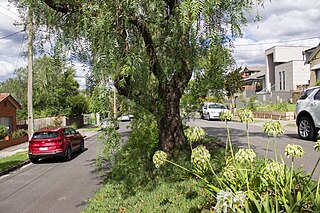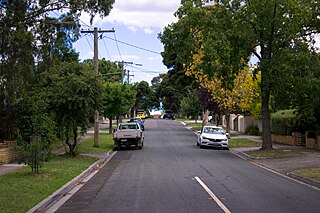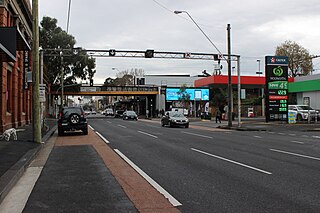Related Research Articles

Kew is a suburb of Melbourne, Victoria, Australia, inner city suburb 5 km east from Melbourne's Central Business District, located within the City of Boroondara local government area. Kew recorded a population of 24,499 at the 2021 census.

Kew East is a suburb of Melbourne, Victoria, Australia, 8 km east from the Melbourne central business district, located within the City of Boroondara local government area. Kew East recorded a population of 6,620 at the 2021 census.

Abbotsford is an inner-city suburb in Melbourne, Victoria, Australia, 2 km (1.2 mi) north-east of Melbourne's Central Business District, located within the City of Yarra local government area. Abbotsford recorded a population of 9,088 at the 2021 census.

Little River railway station is a regional railway station on the Warrnambool line, which is part of the Regional railway network. It serves the southern suburb and town of Little River, in Victoria, Australia. Little River station is a ground level unstaffed station, featuring two side platforms. It opened on 1 January 1857, with the current station provided in 1981.

Matthew Flinders Girls' Secondary College is an all-girls State secondary school located in Geelong, Victoria, Australia. It provides education for students from years 7–12.
Australian non-residential architectural styles are a set of Australian architectural styles that apply to buildings used for purposes other than residence and have been around only since the first colonial government buildings of early European settlement of Australia in 1788.
The Geelong–Ballarat railway line is a broad-gauge railway in western Victoria, Australia between the cities of Geelong and Ballarat. Towns on the route include Bannockburn, Lethbridge, Meredith, Elaine and Lal Lal. Major traffic includes general freight from the Mildura line, and grain.

Kew Lunatic Asylum is a decommissioned heritage-listed psychiatric hospital located between Princess Street and Yarra Boulevard in Kew, a suburb of Melbourne, Australia. Operational from 1871 to 1988, Kew Asylum was one of the largest asylums ever built in Australia. Later known as Willsmere, the complex of buildings were constructed between 1864 and 1872 to the design of architects G.W. Vivian and Frederick Kawerau of the Victorian Public Works Office to house the growing number of "lunatics", "inebriates", and "idiots" in the Colony of Victoria.

Yarra Bend Asylum was the first permanent institution established in Victoria that was devoted to the treatment of the mentally ill. It opened in 1848 as a ward of the Asylum at Tarban Creek in New South Wales. It was not officially called Yarra Bend Asylum until July 1851 when the Port Phillip District separated from the Colony of New South Wales. Prior to the establishment of Yarra Bend, lunatic patients had been kept in the District's gaols. Yarra Bend was proclaimed an Asylum under the provisions of the Lunacy Statute 1867 (No.309) in the Government Gazette in October 1867.

Percy Edgar Everett,, was appointed chief architect of the Victorian Public Works Department in 1934 and is best known for the striking Modernist / Art Deco schools, hospitals, court houses, office buildings and technical colleges the department produced over the next 20 years.

Westgarthtown is a heritage registered precinct located within the Melbourne suburbs of Thomastown and Lalor, in Victoria, Australia.
Robert Guyon Whittlesey Purchas was an Australian architect, especially noted as a pioneer of the Arts & Crafts style seen in a number of large residential projects in the late 1890s and early 1900s. He was the son of prominent architect, civil engineer, and surveyor, Albert Purchas.

John Beswicke (1847–1925) was an architect who practiced in Melbourne between the 1870s and 1915.

The architecture of Melbourne, Victoria, and Australia is characterised by a wide variety of styles. The city is particularly noted for its mix of Victorian architecture and contemporary buildings, with 74 skyscrapers in the city centre, the most of any city in the Southern Hemisphere.
George Strafford was an Australian artist and engraver, active from 1840 to c.1860. Born in India, he moved to Australia in 1851. He is best known for his engraving View of Melbourne (1865), which was published by De Gruchy and Leigh. Under Thomas Ham he contributed to the Australian Illustrated Magazine. Strafford suffered from mental illness and was committed to Carlton Asylum, Kew Asylum and Yarra Bend Asylum. He continued to draw at Yarra Bend, and became known as 'the mad artist'. He died at Beechworth Asylum in Victoria.

Edward Snell (1820–1880) was a diarist, artist, civil engineer and surveyor, responsible for the design of the Geelong – Melbourne Railway for the Geelong and Melbourne Railway Company.
Edward Prowse was an architect working in the Geelong region of Victoria, Australia in the late nineteenth century. He was responsible for many early Geelong buildings, including hotels, mansions and churches.
Albert Purchas was a prominent 19th century architect and surveyor in Melbourne, Australia.
HW & FB Tompkins was an architectural firm established by the brothers Henry (Harry) William and Frank Beauchamp Tompkins in 1898 in Melbourne, Australia. They went on to become a major commercial firm, designing a large number of department stores, hotels, clubs and office buildings and banks over the next 40 years, many in central Melbourne and most still standing. They were stylistic and structural innovators, an area best known for the huge Myer Department store in Bourke Street, built in many stages in different styles from 1914 to 1933.
References
- ↑ Wikisource discussion (German version), Friedrich Ferdinand Kawerau
- 1 2 3 Rootsweb AUS-MELBOURNE-L Archives
- ↑ "Family Haupt genealogical research 'Kawerau". Archived from the original on 28 September 2007. Retrieved 24 March 2014.
- ↑ "wendishheritage.org". Archived from the original on 28 January 2014. Retrieved 24 March 2014.
- ↑ Rootsweb DEU-SCHLESIEN)
- ↑ "Naturalisation problems 1851 style" (PDF). Friends of Westgarthtown News. 13 (2): 5. December 2009. Retrieved 24 April 2017.
- 1 2 3 4 Huddle, Lorraine, 1983-03, Architects of early Geelong [Series of parts] Parts 4-7 Investigator, Vol. 18
- ↑ Willson, Joanne; Bennett, Kirstie, (draftsperson.); Snell and Kawerau (architect.) (1985), Railway Station & Goods Shed, Little River , retrieved 23 March 2014
{{citation}}: CS1 maint: multiple names: authors list (link) - ↑ Australian Heritage Database Terminus Hotel, Geelong
- ↑ "Miles Lewis Australian Building, citing Edward Snell [ed Tom Griffiths], The Life and Adventures of Edward Snell (North Ryde [NSW] 1988), p 379" (PDF). Archived from the original (PDF) on 14 February 2014. Retrieved 23 March 2014.
- 1 2 "Knowle House". Heritage Guide to Geelong College. Retrieved 24 April 2017.
- ↑ Rootsweb Geelong District
- ↑ "Bowie v Wilson. Second Day". The Argus. 30 May 1862. Retrieved 24 April 2017.
- 1 2 "Former Willsmere Hospital (listing VICH861)". Australia Heritage Places Inventory. Department of Sustainability, Environment, Water, Population and Communities . Retrieved 30 August 2008.
- ↑ Cheryl Day unpublished PhD thesis, available in PDF form through the University of Melbourne Library website p.31
- ↑ rootsweb, SE Queensland German families
- ↑ meeting of the Geographical Society of Berlin from 8 January 1870
- ↑ Rootsweb Archive - Sagen family
- ↑ , als Kawerau, F., Baumeister, Frobenstr]
- ↑ Heritage Victoria database
- ↑ "Miles Lewis, Australian Building, citing Edward Snell [ed Tom Griffiths], The Life and Adventures of Edward Snell (North Ryde [NSW] 1988), p 379" (PDF). Archived from the original (PDF) on 14 February 2014. Retrieved 23 March 2014.
- ↑ Australian Heritage Database St Giles Church and Free Church School
- ↑ Victorian Heritage Database, Christ Church, Geelong
- ↑ Victorian Heritage Database St Pauls Geelong
- ↑ Australian Heritage Database Terminus Hotel
- ↑ Victorian Heritage Database
- ↑ On My doorstep Lutheran Church Archived 21 March 2014 at the Wayback Machine ) or 1863/1864 (Kirche.org Archived 21 March 2014 at the Wayback Machine
- ↑ Wuchatsch, Robert (November 2007). "Westgarthtown Lutheran School" (PDF). Friends of Westgarthtown News. 11 (2): 4–6. Retrieved 24 April 2017.
- Elizabeth Malcolm, 'Australian Asylum Architecture through German Eyes: Kew, Melbourne, 1867', Health and History Vol. 11, No. 1, Australian Asylums and Their Histories (2009), pp. 46–64, Published by: Australian and New Zealand Society of the History of Medicine
- Report on the Western Australian expedition of Mr. John Forrest . In: Journal of the Geographical Society of Berlin. 5 Band (1870), pp. 62–68
- Kawerau, Friedrich Ferdinand. In: Hans Vollmer (ed.): General lexicon of visual artists from antiquity to the present. Vol 20 EA Seemann, Leipzig 1927
- Lorraine Huddle, Architects in Geelong in the 1840s and 1850s, 1979, p 49.
- Robert Wuchatsch, Westgarthtown, the German settlement at Thomastown, 1985, p. 18 and 25
- Edward Snell, The Life and Adventures of Edward Snell, 1988, p. 344